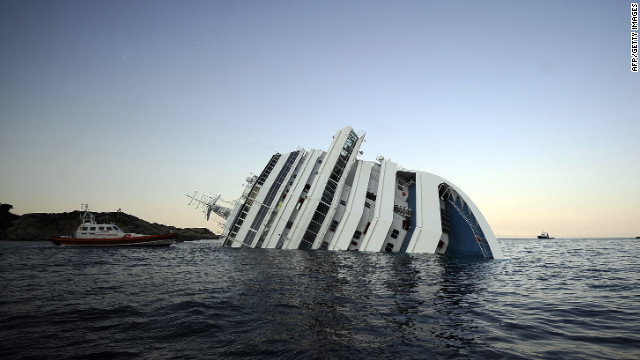Watching early reports about the allision of the cruise liner Costa Concordia on a reef, followed by capsizing. This Getty image:
Three are reported dead, and four dozen missing, but it's extremely difficult to keep track of 4,000-plus people when a ship sinks close to shore, so we can hope some of the missing crew and passengers are safe but unreported.
The ship struck after 10 pm Friday evening. Here's an Associated Press photo of the hull the next day.
While it looks like two photographs stitched together, the brown section between the ocean and the white upper hull is the wrecked lower hull. That's some serious damage! And a big rock too.
It may be hard to believe that a ship traveling weekly on the same Mediterranean cruise route would smash into rocks after so many trips, it's more believable if the ship suffered some kind of power failure shortly before grounding. Modern computerized ships, particularly those relying on thruster pods like the Costa Concordia, are vulnerable to catastrophic power failures. While redundant generators and buses should prevent this, sometimes it happens.
Some reports point to a possible flaw in the navigational charts (a mischarted reef, or an unknown one), but I'd doubt that here. Here are graphics and charts on the Concordia's last voyage, from gCaptain. Fishermen and others who knew the waters said that the ship was off its usual route.
The ship should have a record of events stored on its VDR (voyage data recorder), so the cause of the sinking won't remain a mystery for long. My particular interest is gathering lessons about time-critical, high-stress evacuation, so that's the aspect I'm watching as information emerges about how passengers crawled and climbed off the listing ship and found their way into the lifeboats.



No comments:
Post a Comment